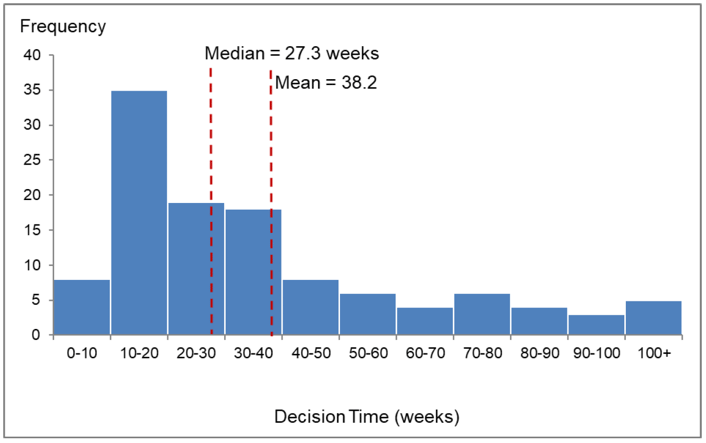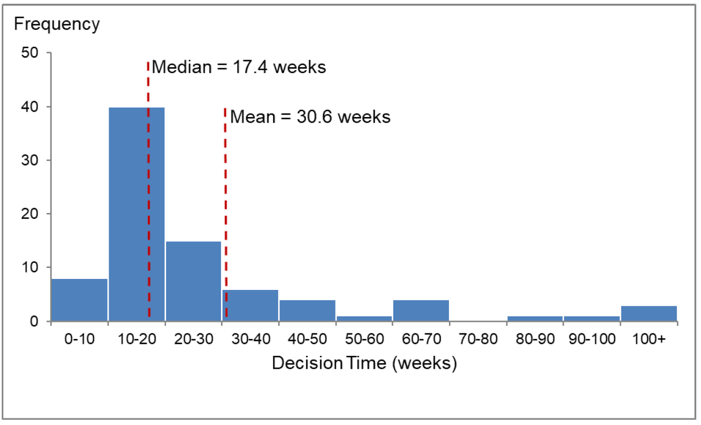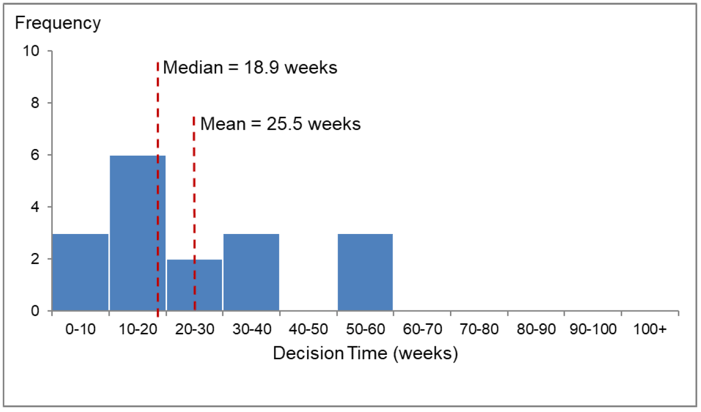Planning performance statistics: fourth quarter 2017-2018 and annual
Latest summary statistics on planning decision-making and timescales for the year April 2017 to March 2018, as well as historic data going back to 2013-2014.
15. Annex
15.1 Stopping the Clock
Stopping the clock is used where there has been a lengthy delay caused by the applicant or external consultees, outwith the planning authority's control. This helps produce more accurate and relevant performance statistics that would otherwise have been skewed by extreme cases of delay outwith the planning authority's control.
For 2017/18 there were 1,394 applications where the clock was stopped for an average of 19.8 weeks. This compares to 1,170 applications stopped for an average of 21.4 weeks in the previous year.
Table 13: Clock stops by planning authority, 2017/18 1,2
| Planning Authority | Total applications decided in 2017/18 | Number of applications with clock stopped | Percentage of applications with clock stopped | Average length of time clock stopped (weeks) |
|---|---|---|---|---|
| Aberdeen City | 919 | 99 | 10.8% | 25.1 |
| Aberdeenshire | 2,035 | 15 | 0.7% | 13.6 |
| Angus | 661 | 3 | 0.5% | 8.3 |
| Argyll & Bute | 1,294 | 46 | 3.6% | 25.1 |
| Cairngorms NP | 1 | 0 | ||
| Clackmannanshire | 229 | 9 | 3.9% | 6.0 |
| Dumfries & Galloway | 1,328 | 28 | 2.1% | 30.6 |
| Dundee City | 616 | 39 | 6.3% | 10.0 |
| East Ayrshire 2 | 519 | 45 | 8.7% | 40.4 |
| East Dunbartonshire | 798 | 63 | 7.9% | 7.3 |
| East Lothian 2 | 991 | 47 | 4.7% | 17.0 |
| East Renfrewshire | 633 | 11 | 1.7% | 23.7 |
| Edinburgh, City of | 3,263 | 5 | 0.2% | 42.5 |
| Falkirk 2 | 607 | 15 | 2.5% | 18.5 |
| Fife | 2,336 | 25 | 1.1% | 11.1 |
| Glasgow City | 2,470 | 219 | 8.9% | 19.3 |
| Highland | 2,889 | 142 | 4.9% | 31.5 |
| Inverclyde | 401 | 57 | 14.2% | 14.4 |
| Loch Lomond & Trossachs NP | 279 | 29 | 10.4% | 17.5 |
| Midlothian2 | 537 | 20 | 3.7% | 55.6 |
| Moray | 761 | 89 | 11.7% | 5.9 |
| Na h-Eileanan Siar | 432 | 5 | 1.2% | 19.8 |
| North Ayrshire | 557 | 31 | 5.6% | 9.7 |
| North Lanarkshire | 900 | 11 | 1.2% | 16.8 |
| Orkney Islands | 419 | 60 | 14.3% | 15.6 |
| Perth & Kinross | 1,601 | 60 | 3.7% | 25.7 |
| Renfrewshire | 692 | 35 | 5.1% | 13.7 |
| Scottish Borders | 775 | 1 | 0.1% | 55.0 |
| Shetland Islands | 296 | 43 | 14.5% | 8.2 |
| South Ayrshire | 956 | 5 | 0.5% | 20.1 |
| South Lanarkshire | 1,478 | 29 | 2.0% | 9.9 |
| Stirling | 812 | 2 | 0.2% | 15.3 |
| West Dunbartonshire | 255 | 56 | 22.0% | 16.7 |
| West Lothian 2 | 711 | 50 | 7.0% | 27.5 |
| SCOTLAND 1,2 | 33,451 | 1,394 | 4.2% | 19.8 |
1. Processing Agreements are not included in this analysis.
2. Includes Legacy Cases
Table 14: Clock stops by development type, 2017/18
| Development Type | Total applications decided in 2017/18 | Number of applications with clock stopped | Percentage of applications with clock stopped | Average length of time clock stopped (weeks) |
|---|---|---|---|---|
| Local developments | ||||
| Householder | 12,861 | 198 | 1.5% | 8.4 |
| Other developments 2 | 5,981 | 295 | 4.9% | 17.7 |
| Housing 2 | 4,768 | 440 | 9.2% | 23.5 |
| Business and Industry | 1,609 | 114 | 7.1% | 19.6 |
| Telecommunications | 504 | 22 | 4.4% | 13.0 |
| AMSCs | 284 | 36 | 12.7% | 19.7 |
| Electricity Generation | 123 | 17 | 13.8% | 18.9 |
| Waste Management | 17 | 3 | 17.6% | 9.5 |
| Minerals | 17 | 6 | 35.3% | 34.6 |
| Marine Shellfish Farming | 32 | 2 | 6.3% | 6.1 |
| Marine Finfish Farming | 24 | 6 | 25.0% | 16.0 |
| Freshwater Fish Farming | 0 | 0 | - | - |
| TOTAL | 26,220 | 1139 | 4.3% | 18.6 |
| Major developments | ||||
| Housing2 | 116 | 46 | 39.7% | 50.1 |
| Other Developments | 83 | 14 | 16.9% | 32.5 |
| Business and Industry | 17 | 3 | 17.6% | 59.1 |
| Electricity Generation | 9 | 1 | 11.1% | 73.1 |
| Minerals | 8 | 3 | 37.5% | 46.6 |
| Waste Management | 5 | 2 | 40.0% | 19.8 |
| Marine Shellfish Farming | 0 | 0 | - | - |
| Freshwater Fish Farming | 0 | 0 | - | - |
| Marine Finfish Farming | 0 | 0 | - | - |
| TOTAL | 238 | 69 | 29.0% | 46.2 |
| Other Consents | ||||
| Listed bldg.+con.area consents | 3,302 | 103 | 3.1% | 19.2 |
| Advertisements | 1,849 | 58 | 3.1% | 12.7 |
| Other consents and certificates | 1,801 | 5 | 0.3% | 27.0 |
| Hazardous substances consents | 18 | 11 | 61.1% | 8.9 |
| TOTAL | 6,970 | 177 | 2.5% | 16.6 |
| Local with EIA | ||||
| Local Developments Subject To EIA | 10 | 6 | 60.0% | 48.0 |
| AMSCs (Subject to EIA) | 8 | 3 | 37.5% | 14.9 |
| TOTAL | 18 | 9 | 50.0% | 37.0 |
1. Processing Agreements are not included in this analysis.
2. Includes Legacy Cases
For 2017/18, local housing developments have the most applications where the clock has been stopped, with 23.5 weeks on average removed from decision times. This represents 9.2% of all applications for local housing developments. There are a variety of reasons why the clock is stopped but stops are often due to delays in concluding legal agreements and waiting for the applicant to sign a planning obligation. Other reasons include site survey required in relation to European protected species that must await a particular season, external consultants delay or awaiting advert fees to be paid.
Stop the clock advice has been issued to planning authorities to help with decisions for stopping the clock and is available at;
http://www.gov.scot/Topics/Statistics/Browse/Planning/DataSupplierArea
15.2 Distribution of decision times for major applications.
Chart 60: Distribution of decision times for major housing developments (post 3rd August 2009), 2017/18 (excludes 2 legacy cases)

The vertical line at 38.2 weeks shows the mean (average) decision time for major housing developments. The second line at 27.3 weeks shows the median decision time. Decision times range from 5.1 weeks to 170.7 weeks. The chart shows that the mean decision time has been influenced by several lengthy decisions. Almost 65% of major housing applications were decided in a time quicker than the average of 27.3 weeks. Nearly 47% of major housing applications were decided within 6 months.
The five lengthiest decisions took 117.9 weeks (2.3 years), 124.4 weeks (2.4 years), 137.7 weeks (2.6 years), 147.0 weeks (2.8 years) and 170.7 weeks (3.3 years).
The lengthiest application was for planning permission in principle for a residential development for 60 dwellings in Midlothian that also included erection of a warehouse and extension to an existing petrol filling station kiosk. The application was approved.
Chart 61 shows the distribution of the decision times for major other developments (post 3rd August 2009) concluded in 2017/18. The category "other developments" includes any developments not falling wholly within any of the specific categories of development for minerals, housing, business & industry, waste management, electricity generation, fish farming. It includes, but is not limited to, retail, leisure and entertainment, education, healthcare, community facilities, transport interchanges, water and drainage developments and projects. It can also include mixed use projects.
Chart 61: Distribution of decision times for major other developments ( post 3rd August 2009 ), 2017/18

The vertical line at 30.6 weeks shows the mean (average) decision time for major other developments. The second line at 17.4 weeks shows the median decision time. Decision times range from 4.1 weeks to 380.1 weeks. The chart shows that the average decision time has been influenced by several lengthy decisions. Just over three quarters of major other developments were decided in a time quicker than the average of 30.6 weeks and almost 70% were decided within 6 months.
The lengthiest decision, which was in South Lanarkshire, took 380.1 weeks (7.3 years) and was for planning permission in principle for a 160 hectare site described as a development of Community Growth Area, comprising housing, neighbourhood centre, community facilities, access roads, open space and landscaping (Planning in Principle). The application was approved.
Chart 62 shows the distribution of the decision times for major business and industry developments (post 3rd August 2009) concluded in 2017/18. The category " business and industry" developments include construction of a building or structure for any of the following: use as an office, for research and development of products or processes, for any industrial process or for use for storage or as a distribution centre. To be classed as major the gross floor space as a result of the development must exceed 10,000 square metres or the site area must exceed 2 hectares. Due to the small numbers of applications for major business and industry developments, average decision times are very variable.
Chart 62: Distribution of decision times for major business and industry ( post 3rd August 2009 ), 2017/18

The vertical line at 25.5 weeks shows the mean (average) decision time for major business and industry developments. The second line at 18.9 weeks shows the median decision time. Decision times range from 5.7 weeks to 60.0 weeks. Almost 59% of major business and industry applications were decided in a time quicker than the average of 25.5 weeks with the same number decided within 6 months.
The lengthiest decision, taking 60.0 weeks is in Glasgow and is described as a mixed use development including offices, residential units, hotel and associated ground floor commercial uses with access, parking and landscaping. The application was approved.
Chart 63 shows the distribution of the decision times for the remaining major applications (post 3rd August 2009) that were concluded in 2016/17. These include applications for minerals, waste management and electricity generation.
Chart 63: Distribution of decision times for remaining major applications ( post 3rd August 2009 ), 2017/18

The vertical line at 26.8 weeks shows the mean (average) decision time for the remaining major developments. The second line at 16.1 weeks shows the median decision time. Decision times range from 5.0 weeks to 119.7 weeks. The chart shows that the average decision time has been skewed by a few lengthy decisions. Just over 68% of the remaining major applications were decided in a time quicker than the average of 26.8 weeks, all of these were decided within 6 months.
The lengthiest decision that took 119.7 weeks was an application for electricty generation in Dumfries and Galloway and involved erection of 14 wind turbines, 1 meteorological mast, 1 telecommunications mast, 6 temporary meteorological masts, substation / control building and temporary construction compound along with construction of crane hardstandings, access tracks and associated infrastructure.
15.3 Planning Performance Guidance
Detailed guidance is available to planning authorities to help with submission of quarterly data. This can be found here:
http://www.gov.scot/Topics/Statistics/Browse/Planning/DataSupplierArea
15.4 Calculation of cut-off date for 2 month target
Months are measured from a specific day in one month until the day with the preceding date in the following or subsequent months. Further guidelines on how this is calculated can be found here:
http://www.gov.scot/Topics/Statistics/Browse/Planning/DataSupplierArea
15.5 Statistics for other UK countries
Information and statistics on planning applications for the other UK countries can be accessed at the following links:
England: https://www.gov.uk/government/collections/planning-applications-statistics
Wales: http://wales.gov.uk/topics/planning/planningstats/?lang=en
Northern Ireland: http://www.planningni.gov.uk/index/tools/about-statistics.htm
Contact
There is a problem
Thanks for your feedback